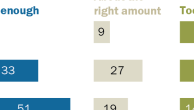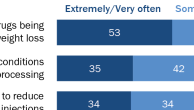Remarks by Susannah Fox of the Pew Internet & American Life Project at the Health 2.0 conference in San Diego, CA, on March 4, 2008.
The Pew Internet Project studies the social impact of the internet.1 We began tracking online life in March 2000, which turned out to be just at the tail end of the first dot-com bubble.2 After the market crash, there were quite a few people on the internet sidelines who were eager to say “I told you so” and warn people against the dangers of the internet. My favorite example is the 2001 press release from the American Medical Association suggesting that Americans make a New Year’s resolution to “trust your physician, not a chat room” since the information found online puts “lives at risk.”3
Of course most people ignored that advice and flocked online for health information, just as they ignored the advice of the recording industry and flocked to music downloading sites. When 80% of internet users are doing something, the horse is out of the barn.
My research has focused on the internet’s impact on health and health care, particularly the group of internet users who gather and share health information online. We have come to call them “e-patients” and “e-caregivers.”
E-patients have always been at the center of this revolution, marching forward with or without the help of industry leaders. They are the worried well using search engines to look up basic advice. They are the chronically ill using discussion forums to trade in-depth knowledge. Or as one e-patient wrote in one of our online surveys, “we are lab rats tapping out messages on the bars of our cages.”
But let’s give the AMA some credit. Inaccurate and outdated medical information does exist online. Our surveys find that the internet’s fire hose of information can be overwhelming and confusing, particularly for people with a high school education or less, which represents about 40% of American adults. But there may yet be some hope.
You may have heard about Michael Pollan’s new book, In Defense of Food. His answer to all our diet worries is summed up in seven words:
Eat food. Not too much. Mostly plants.
You may also have seen The New York Times’ Seven-Word Wisdom contest on Tara Parker-Pope’s blog. Here are my favorite entries:
Eat pie. Very good pie. Not often.
Call Mom. Let her talk. Don’t argue.
Make promises. Don’t break them. Find loopholes.
I have been wondering if there is equivalent wisdom for our “information worries,” a filter for that fire hose of data & advice, imagery & sound. In health care especially people are under stress and need to process a lot of complex information. How can people possibly find the good stuff?
Medical librarians say people should check the source and date of the health information they find online. But few sites display those quality markers and few e-patients look for them. Displaying the source and date is of course a special problem for Health 2.0 and the e-patients who want to share their knowledge or are looking for someone ahead of them on the treatment path, that “just in time someone like me” who can really make a difference. Health 2.0 is not a traditional information source.
A new study published in the journal Cancer recently confirmed what Josh Seidman of the Center for Information Therapy has also written about: the display of the source and date on a page is not correlated with the presence of high-quality information. The absence of those two markers is also not correlated with low-quality information. The one marker for inaccuracy found in the Cancer study was the presence of information about complementary and alternative medicine or CAM. CAM pages were 15 times more likely than other pages to contain inaccurate information. Going back to the Seven-Word Wisdom contest, the Cancer article might be summarized as follows:
Go online. Use common sense. Be skeptical.
That might resonate with people who say we should trust users to find the good stuff and ignore the bad stuff. Indeed, our surveys show that this ad hoc system has worked pretty well. About one-third of e-patients say they or someone they know has been significantly helped by following medical advice or health information found on the internet. Just 3% of e-patients say they or someone they know has been seriously harmed by following the advice or information they found online. Reviews of the medical literature have also turned up very few cases of bad outcomes related to the internet.
But don’t you think it’s time for health care to take things to the next level? My friend Charlie Smith of eDocAmerica has written about the “space in between “doctor knows best” and “leave the e-patient alone” and that is a high quality, interactive partnership between physicians and their e-patients. Engaging large numbers of providers in the world of online communication with and between patients about health issues is the best way, according to Charlie Smith and many people in this room, to craft a new model of higher quality medical care.
Health 2.0 tools can facilitate that world of online communication.
Since you are here at the patient-centered Health 2.0 conferences you are probably not making the classic mistake of creating tools and systems that don’t place users at the center. Ask yourselves and your colleagues what Diana Forsythe asked in Studying Those Who Study Us: Whose assumptions and whose point of view are inscribed in the design of this tool?
Don’t be the AMA circa 2001 or the recording industry, clinging to your own notions of what should be. Design for what could be.
When health care does move to the next level, can we be sure it’s not leaving some people behind? Pew Internet Project research shows that the base of the internet is broadening. Where we once saw an internet population dominated by college-educated adults, we now see many people with a high school education or less going online. People with less education have lower levels of health literacy and numeracy – basic reading and math – which is a big deal when you are managing diabetes, for example. People with less education are less confident navigators of the online world.
The Pew Internet Project’s current estimate is that about 75% of adults and 95% of teenagers in the U.S. go online. Half of American adults have broadband access at home. 75% of American adults have a cell phone and many are using their cell phones to connect to the internet.
To unpack that further, my colleague John Horrigan has sorted American adults into three broad categories related to which technology assets they own, what actions they take with those gadgets, and the attitudes they express toward information and communications technology.
For example, how many people in this room agree with the following statements:
- I like that cell phones and other mobile devices allow me to be more available to others
- When I get a new electronic device, I usually need someone else to set it up or show me how to use it
- I often feel annoyed by having to respond to intrusions from my electronic devices
- I believe I am more productive because of all of my electronic devices
When you hear the phrase “2.0” you are hearing about an online world that is familiar to what we call the “Elite Tech Users,” who make up one-third of all adults. They have lots of gadgets and they like them. For them, the internet has changed from being slow and stationary to being fast and mobile. Elites don’t just surf through the online world, they shape it.
An early example of participatory medicine is the Association of Cancer Online Resources or ACOR.org, which is a collection of listserves, going strong since 1995. Participants say they gain knowledge and support that they can’t get elsewhere. But a University of North Carolina study of the group revealed its membership to be 98% white, 86% college-educated. The UNC researchers convened a meeting to discuss the “whiteness” of online health communities, and some of the reasons put forward for low participation among African Americans included:
- unfamiliarity with computers and even basic keyboard skills, especially among seniors
- rules against the discussion of God and faith
- historical distrust of doctors and medicine (memories of the Tuskegee Syphilis Experiment are fading in the younger generations, but are still present)
In conclusion, Web 2.0 is not familiar ground for the majority of the U.S population. Many people could benefit from resources made possible by the participatory internet, but they may not have the skills, the need, or the desire to do so. How will these people fare when the best health care is available only to those who are willing to expand beyond traditional health information sources like doctor’s appointments and print media? How will Health 2.0 attract and serve the majority, not just the elite?
I have one answer for that question, based on new data coming out this week which shows how African American and Latino adults are more attached to their cell phones than to the internet, to TV, or to landlines. Reaching people through their mobile devices could be – maybe – a way to expand the Health 2.0 population.
In the spirit of Michael Pollan’s diet wisdom: If we wrap up all we have observed over the first 5,000 days of the Web and mix it with the wisdom of medical professionals and e-patients, then add a dash of the next big technological wave, we may get an answer to our information worries. Here is my Seven-Word Challenge for Health 2.0:
Recruit doctors. Let e-patients lead. Go mobile.




